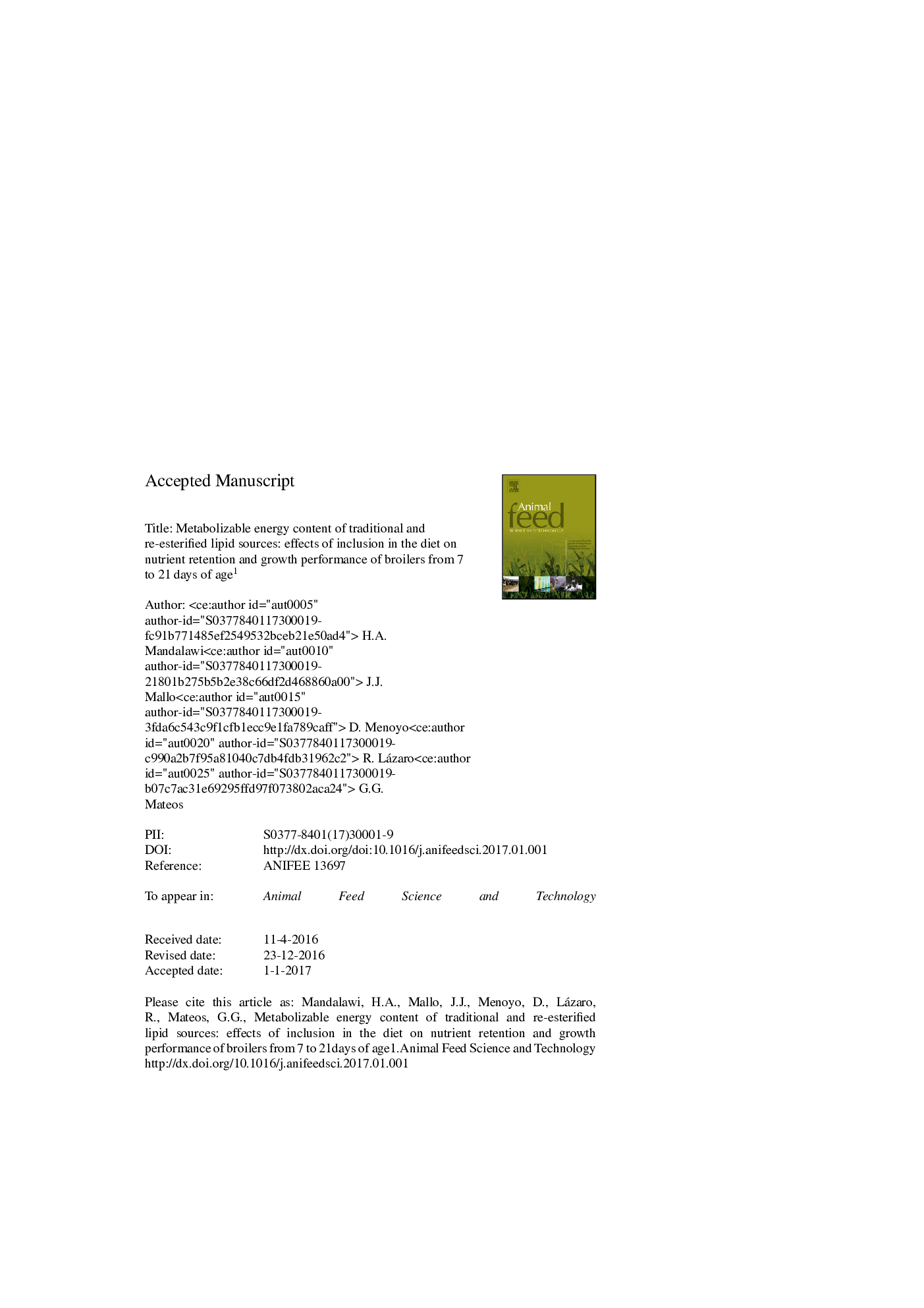| Article ID | Journal | Published Year | Pages | File Type |
|---|---|---|---|---|
| 5538789 | Animal Feed Science and Technology | 2017 | 36 Pages |
Abstract
The apparent metabolizable energy (AME) of traditional and re-esterified lipid sources and the effects of its inclusion in the diet on nutrient retention and broilers performance were studied in two experiments (Exp) from 7 to 21 d of age. In Exp 1 there was a control diet without any supplemental fat and three extra diets that included 25Â g/kg of soy oil (SO), re-esterified monoacylglycerol (RMAG) or re-esterified triacylglycerol (RTAG) at the expense (wt:wt) of the control diet. The gross energy (GE, MJ/kg) of the oils was 39.66, 38.06 and 38.56, respectively. Fat supplementation increased EE retention (PÂ <Â 0.001) and improved feed to gain ratio (F:G) (PÂ <Â 0.01) from 7 to 21 d of age but did not affect average daily gain (ADG). In Exp 2, the design was the same than in Exp 1 but the experimental diets included 50Â g/kg of SO, acidulated soapstocks (ASO), lard, RMAG, RTAG or a 20:80 mixture of SO and RMAG (SO-RMAG). Supplemental fat increased GE and EE retention (PÂ <Â 0.001). Dry matter (DM) and GE retention was higher (PÂ <Â 0.001) for broilers fed the SO or lard containing diets than for broilers fed the re-esterified oils containing diets. The AME of the supplemental fats was greater for the SO and lard than for the RMAG, RTAG, with SO-RMAG and ASO being intermediate (PÂ <Â 0.01). Fat supplementation improved ADG (PÂ ËÂ 0.05) and F:G (PÂ ËÂ 0.001) of the broilers. The AME of the lipid sources was determined by two methods a) multiplying its GE by the retention of the ether extract (EE) of their respective diets and b) by difference between the AME of the control and the corresponding experimental diet. The AME content of the supplemental fats, except for the re-esterified oils in Exp 2 was higher when calculated by difference between the AME of the control and the fat containing diet than when measured directly from the GE and EE digestibility data. Also, the AME of the supplemental fats was higher when included at 50Â g/kg than when included at 25Â g/kg. In conclusion, all the fat sources were well utilized by broilers, at both levels of inclusion. The RMAG and RTAG oils presented AME values within the range of those reported for the more traditional fat sources.
Keywords
ADGMAGASOTMEFFAmonoacylglycerolADFIEXPAMERmagF:Gfeed to gain ratioExperimentsamino acidFatty acidFree fatty acidMetabolizable energyapparent metabolizable energygross energytriacylglycerolTAG یا triacylglycerols diacylglycerolsDAGLardether extractorganic matterdry matteraverage daily gainSoy oilAverage daily feed intakeNitrogenbody weightcrude protein
Related Topics
Life Sciences
Agricultural and Biological Sciences
Animal Science and Zoology
Authors
H.A. Mandalawi, J.J. Mallo, D. Menoyo, R. Lázaro, G.G. Mateos,
